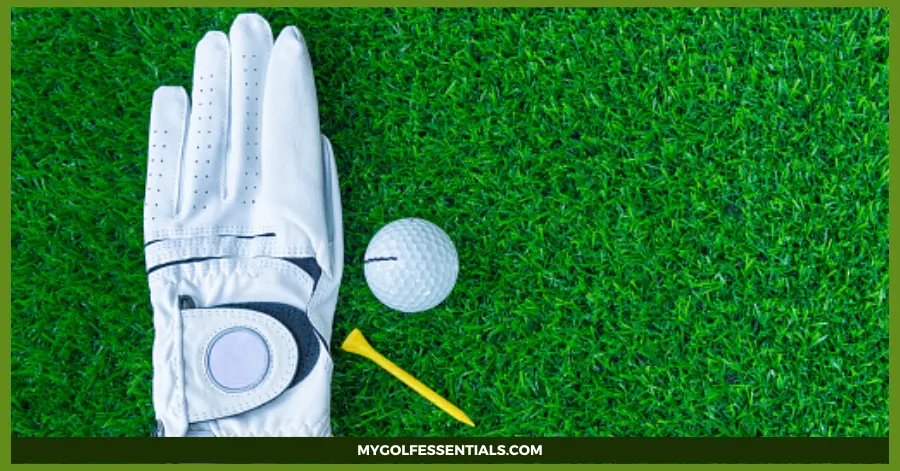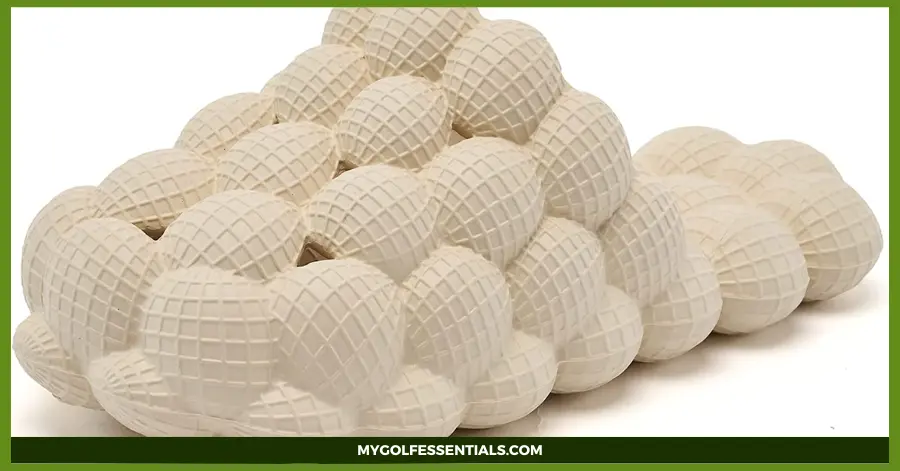
Balata golf balls get their name from the material they are made of, unsurprisingly named balata, extracted from a tropical tree. It is famous for its softness and stretch factor, which work just as well when the substance is turned into a ball, giving it an adorable squish and spin. Yet, while balata golf balls may seem appealing due to these distinctive features, they are only sometimes suitable for some golfers.
These balls are crafted to cater to professionals and experts who know how to skillfully utilize the ball to its absolute limits, taking full advantage of the spin characteristics they offer. However, it can be challenging for newcomers to handle these balls since they are very soft and get damaged a lot. Today, we will get deep and personal with these balls to determine what makes them work and how to use them best.
Introduction to Balata Golf Balls
Balata golf balls stand out in the market for their unique features and distinct advantages. The primary distinguishing factor is their softness, derived from the balata material. This softness imparts a high degree of control over spin, allowing skilled golfers to manipulate the ball’s trajectory per their exact requirements.
The increased spin control can significantly improve the accuracy of shots, especially in scenarios demanding precise placement. Moreover, balata golf balls ensure a softer feel upon contact, which can enhance the player’s touch and feedback response, providing a more intuitive playing experience. The squishiness and elasticity also make the ball go much faster and longer.
But the elephant in the room is right there: a ball so soft must be easily broken. And yes, that is the case; the balls are very soft and squishy, which in turn means they can be easily broken, but this is a ball made for extra control over the ball, so it’s meant for the experts who are better suited to handling a ball without damaging it.
Exploring the Features of Balata Golf Balls
Balata golf balls are favoured by many professional players and experienced amateurs for their supreme spin control. But what makes these balls so unique? Let’s dive deeper and look at the features, including the super soft cover that gives it a soft, distinct feel.
The balata material is naturally soft and elastic, making it ideal for golf ball construction. This softness also imparts the higher spin control that these balls are famous for, as the softer cover layer compresses more upon impact with the clubface, grabbing onto the grooves of the club head.
What this does is that it makes the ball spin so much faster and helps make curve shots more accessible, but the softness also means you can break it if you hit hard. Therefore, balata golf balls require extra care to maintain their performance levels.
Understanding the Material – Balata
Balata is a milky-white latex produced by the tropical Manilkara bidentata tree, also known as the bulletwood tree. Rich in gutta-percha, a type of trans-polyisoprene, balata shares similar properties to natural rubber but with a higher hardness. This inherent elasticity and hardness make balata a distinctive choice for golf ball manufacturing.
The balata cover on the golf balls is thinner than the covers made from other materials. This thin layer directly impacts the ball’s core during a shot, promoting a more effective energy transfer and increasing the potential shot distance. However, the balata’s softness makes these balls highly responsive to the clubface’s grooves at impact, which can significantly enhance the spin.
This high spin can be an advantage in terms of offering great control over the ball’s trajectory, but it also demands a heightened level of skill from the golfer. On the flip side, the softness of the balata results in a less durable golf ball. Despite their superior performance characteristics, balata golf balls tend to wear out faster, mainly when used by less experienced players likelier to hit off-center shots.
These balls are more susceptible to cuts and abrasions, meaning they might not last as long as their more complex, surlyn-covered counterparts. Thus, while balata golf balls might offer unparalleled control and a soft feel, their longevity, and cost-effectiveness are factors that golfers must consider.
The Soft Feel of Balata Golf Balls
The distinctive softness of balata golf balls significantly contributes to their overall performance. This softness is particularly notable upon impact, where the ball compresses and deforms more readily than more complex alternatives, leading to a more effective energy transfer from the clubface to the ball. This results in a potential increase in shot distance and a markedly softer feel, providing golfers with greater control and nuance in their shots.
Furthermore, the softness of balata contributes to the high spin rates associated with these balls. When the clubface strikes the ball, the soft balata cover grips the clubface’s grooves more effectively, generating more spin. This enhanced spin control allows skilled golfers to manipulate the ball’s trajectory better, an advantage crucial in strategic play and precision shots.
However, the softness of balata golf balls also comes with a trade-off in durability. The same soft cover that grants control and a soft feel is also more prone to cuts, scrapes, and other forms of damage, particularly from off-center shots. Therefore, while the softness of balata significantly enhances the performance characteristics of these balls, it is a factor that requires golfers to marry their skill level with the cost-effectiveness and longevity of their chosen golf ball.
Exceptional Spin Control with Balata Golf Balls
Balata golf balls are renowned for their exceptional spin control, a critical factor in precision play. The spin control can largely be attributed to the soft and elastic nature of the balata cover. When the clubface hits the ball, it squishes hard and digs deep into the grooves of the club’s head.
This creates a lot of friction, making the ball spin faster and curve better. All this, when simplified, means that the ball can curve and curve hard. It is perfect for situations where you must turn the ball a lot if you are playing on an uncertain or uneven terrain.
But don’t expect greatness if you just started because these balls are no joke regarding how much skill you need to use them correctly. Hence, while the enhanced spin control offered by balata golf balls can be a significant advantage, it demands a nuanced understanding and command over one’s swing mechanics.
Balata Golf Balls and Durability
When discussing the durability of balata golf balls, one must acknowledge that they are less durable due to their softness. Being soft, they are much easier to spin but easier to tear and cut, just like human skin, and in golf, the situation always calls for skill and precision, which can mean the balata ball can’t always take the strain.
The more you miss the center, the more likely you are to damage the ball in a way that leaves a tear; although it’s a great ball, it can’t last for too long when put under strain. Golfers must maintain a careful balance if they use this ball to the fullest because it is very delicate and thus could be better for people who are used to it.
Comparative Analysis: Balata vs. Other Golf Balls
Several differences come into focus when comparing balata golf balls to others, such as surlyn-covered or urethane-covered balls.
Surlyn-Covered Balls
Surlyn-covered balls are known for their durability and distance. The resilient surlyn material can withstand the high-impact strikes of golf, resulting in balls that resist cuts, scrapes, and scuffs and last longer. However, this hardness compromises control, with surlyn balls offering less spin and a more rigid feel than balata balls.
Thus, while surlyn balls may be a more cost-effective choice for casual or less skilled golfers, they may offer a different level of performance and control desired by more experienced players.
Urethane-Covered Balls
Urethane balls are more between Balata and Surlyn; they are much more demanding than Balata while still being a little soft and not breaking. However, urethane balls are typically more expensive, making them a significant investment.
Ideal Users of Balata Golf Balls
Balata golf balls are best suited to golfers with a high degree of skill and a refined swing. These players can use the enhanced control, soft feel, and increased spin balata offers. They are usually more concerned with the soft and more precise ball than how far it is supposed to go.
Furthermore, they are often players who regularly compete in tournaments or serious matches where the subtleties of balata’s performance characteristics can make a meaningful difference in the outcome. However, due to the balata’s reduced durability and cost-effectiveness, these balls are not typically recommended for beginners or high-handicap golfers.
These players, who may have yet to hone their swing mechanics fully, might find the higher spin rates and the resulting unpredictability challenging to manage. Additionally, their more frequent off-center hits could lead to rapid wear and tear, making balata balls a costly choice.
So, while balata golf balls offer exceptional performance, they cater to a specific segment of golfers – those with the skill to exploit their advantages and the willingness to invest in their higher cost and lower durability.
Pros and Cons of Balata Golf Balls for Novices
Pros:
- It provides exceptional spin control, which can help beginners learn and understand the impact of their swings.
- It offers a soft feel, making judging the contact between the clubface and the ball easier.
- Encourages precision and shot-shaping due to its responsive nature.
Cons:
- They are less durable than other golf balls, leading to higher replacement costs for novice players who may hit more off-center shots.
- The higher spin rates can be challenging for beginners, resulting in inconsistent shots and potentially hindering skill development.
- Balata balls may provide a different distance than other golf balls, which could be discouraging for novice players who are still building strength.
Maintenance and Care for Balata Golf Balls
- Clean Regularly: Due to their softer cover, balata golf balls can accumulate dirt and other residues faster than their more rigid counterparts. Regular cleaning will preserve the look of the ball and maintain its performance. If you have warm water, put some soap in it and use it to wash the balls carefully after each round.
- Avoid Rough Surfaces: It should be obvious, but if you want the balls to last for long, you should ensure they are not constantly bumping into rough surfaces and harsh areas.
- Rotate Usage: If you have a lot of balls, you should rotate between balls each round so they last longer and you don’t have to replace them too soon.
- Store Properly: Much like medicine, a cool and dry place is excellent for storing the balls. They shouldn’t be in sunlight for too long, and you should make sure the balls aren’t in a humid place.
- Inspect Regularly: Much like any other golf ball, you should stop and check on them occasionally to ensure they are not destroyed in a way that can be too distracting for your play.
- Limit Use During Practice: Just from how easy to break the balls are, it would be in your best interest to not take them out for a spin every two days or so; make sure you use them less since they are made for specific purposes.
FAQs
What does Balata mean in golf?
Balata is a type of rubber material that was traditionally used as the cover for golf balls. It offers a soft feel and increased spin control but at the cost of reduced durability. Now, balata has been replaced by other materials such as urethane and surlyn, but many golf enthusiasts still use the term “balata” to refer to these balls. So, when discussing balata golf balls, it typically refers to those with softer covers that provide increased spin and control.
Who would benefit most from using balata golf balls?
Balata golf balls are best suited for highly skilled and experienced players who prioritize control, precision, and spin over distance. These golfers are typically low-handicap players who regularly compete in tournaments or serious matches where the subtleties of balata’s performance characteristics can make a meaningful difference in their score. They also have the budget to invest in these higher-priced and less durable balls.
Can beginners use balata golf balls?
While balata golf balls offer unique benefits, they are not typically recommended for beginners or high-handicap players. The increased spin rates and softer feel can be challenging for those who still need to hone their swing mechanics fully. Also, their frequent off-center hits could lead to quicker wear and tear, making them a costly option for beginners needing to replace their balls more often.
How can I extend the lifespan of my balata golf balls?
To maintain the performance and durability of your balata golf balls, it’s essential to clean them regularly with warm, soapy water and a soft cloth. Avoid hitting them on rough surfaces or into obstacles, rotate their usage, store them in proper conditions, and inspect them for any damage regularly. Consider limiting their use to competitive matches rather than practice sessions to prolong their lifespan.
Conclusion
This guide has provided valuable insights into balata golf balls and helped you determine if they are the right choice for your game. While balata balls offer unique benefits, they are only suitable for some due to their lower durability and higher cost. However, these balls can be a game-changing investment for highly skilled players prioritizing control and spin over distance. Remember to properly maintain and care for your balata golf balls to ensure optimal performance and longevity.



